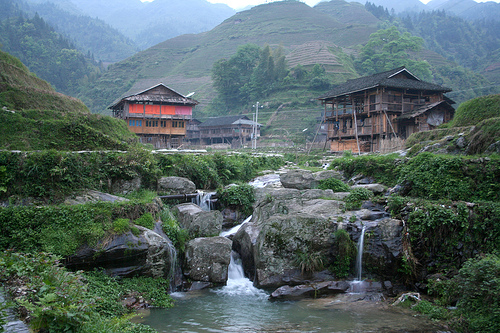Check out our Top Rewards Cards to boost your points earning and travel more!
Professor Peter Conn continues his teaching romp through China. Check out parts 1, 2, and 4.
Intersession
As predicted, nothing much of note occurred during the seven days of teaching. With a couple of exceptions, one of them the first (trivial) violence I have experienced in China.
One cool, lovely evening I took a walk by myself along the banks of one of Guiyang’s smaller rivers. Peddlers and hucksters had set out their various stalls, selling everything from musical instruments and sandals to tee shirts and fruit. (I bought a half-dozen apples.) A crowd had gathered around one stall, which offered what appeared to be a magic elixir for the eyes: demonstration in progress. I lifted my camera to point and shoot, but between the pointing and the shooting, a small, heavy-set man – I figure him for a middle-weight – rushed over and shoved me to the ground. No damage, except to my dignity. And to my apples, which spilled out of their flimsy bag. He stood over me, wagging his finger at the camera. Ah, I managed to conclude: nothing personal, but no pictures allowed. Apparently (I conjectured, and later confirmed) the magic elixir is illegal – what a bummer for free enterprise! – and picture-taking potential informers are not welcome. I walked away with as much nonchalance as I could summon, and made a conspicuous stop to buy another bag of apples.
At their initiative, the seminar participants re-designed the closing event, ditching the round of tiresome speeches and toasts for an evening of amateur folk singing. Specifically, they divided themselves into small groups by home region, and offered good-to-awful renditions of (allegedly) traditional songs: Inner Mongolia was represented, along with Yunnan, Sichuan, Shaanxi, Tibet, and Xinjiang. The absolute highlight was “Hard to Crack a Smile With You on My Mind,” belted out in the Dong dialect by the seven year old daughter of the Guizhou U dean. A star was born: adorably cute, and feisty, and very funny. She would travel with us on our intersession sightseeing, and we would become great pals. Eventually, she demanded that I give her an American name, so she became Terry for the duration. (Or Terry junior.)
On the first day of the intersession, we traveled by bus to the locally famous semi-ancient village of Qing Yan. Semi-devastated by Mao’s Cultural Revolutionaries, semi-restored, semi-authentic, and semi-fake, Qing Yan offers a typical mix of Chinese past and present. The town had been home to Buddhists, Daoists, and Christians, and the most prominent buildings are the temples and churches these religionists constructed. It didn’t take much expertise to disentangle the rebuilt, restored, renovated bits from what might have survived. All rather sad, and more instructive about China’s recent internecine violence than its older cultural history. Primarily, in any case, the town’s narrow, twisty lanes are crowded with the inevitable peddlers’ stalls, mostly selling kitschy souvenirs. My hosts were slightly embarrassed by this micro-capitalist intrusion on “heritage,” so I gave them face by assuring them that they would have found the same loud and unsoaped confusion surrounding any European cathedral in the Middle Ages. This made them feel slightly better, or so they claimed.
Tien He Tan Park
Despite my half-sincere efforts to reassure them (see preceding graph), the Chinese do have an uncanny capacity for junking up their treasures. Nothing stands in the way of development or of a dimwitted appeal to tourism. Case in point. After our visit to Qing Yan, we motored to a large and cheerfully scenic country park, called Tian He Tan. Down a steep walkway to the bottom of a high and dramatic limestone cliff. Into a small rowboat which took us through a mile (as in: one full mile) of underground river: cut by the water over centuries and unlike anything I’ve seen before. The channel is sometimes so low and narrow that we were all ordered to “become small” (harder for me than some others), then opens into a high-ceilinged cathedral of stone, then narrows again, and so on. Terry junior held my hand and sang a few songs from her repertory to stay calm. Quite breathtaking, but . . . .
I concede that some lighting is necessary; otherwise we would see nothing. But the managers – proving that necessity can also be the mother of vulgarity – have chosen to festoon the stalactites and projecting rocks with strings of blinking lights in four or five different (and changing) colors. It is like drifting through a badly decorated Christmas tree. The contrast between the transfixing natural beauty and the cheesy lighting almost (not quite) turned sublimity into low comedy.
Exit on foot is through a mile or so of tortuous and steeply pitched caverns, narrow passages once again yielding to vast stone chambers. I am told that these are some of the most extensive caverns in China, and they offer eye-popping formations around every corner. Alas, lighting (it almost goes without saying) is more of the same: a hanging necklace of stalactites carefully outlined with blinking colored lights, intricate twisted stalagmites ditto, a river tumbling over a low cliff, ditto.
The day concluded with my crowning achievement on this trip: riding a zip rope 400 meters (=1500 feet) over a beautiful valley in the park. Altitude 200 feet above the ground. And I have a photo to prove it. None of the other elderly faculty would do it, nor most of the non-elderly, so I was joined in the adventure by just three young teachers. My credibility has never been higher; all of Guizhou province is abuzz.
The only slightly hairy moment came at the end. I had been instructed to pull the brake rope when I neared the landing zone; I did and nothing happened. I had visions of flattening myself against the back wall but the resourceful attendant tackled me as I flew by.
Text by Peter Conn © 2011, all rights reserved, reprinted with permission. Reference hyperlinks and images selected by The Rapid Traveler, images licensed under Creative Commons.
Check Out Our: Top Rewards Cards ¦ Newsletter ¦ Twitter ¦ Facebook ¦ Instagram


